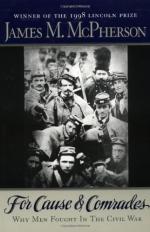
|
| Name: _________________________ | Period: ___________________ |
This quiz consists of 5 multiple choice and 5 short answer questions through Chapter 5, Religion is What Makes Brave Soldiers.
Multiple Choice Questions
1. During his visit to the four Civil War battlefields near Fredericksburg, McPherson thinks about the fighting that happened on May 12, 1864; for how many hours did the battle last?
(a) 18.
(b) 4.
(c) 9.
(d) 27.
2. As the excitement for battle raced across the country, the governor of Ohio said he could not send the requested thirteen regiments but would send how many?
(a) 5.
(b) 8.
(c) 16.
(d) 20.
3. When McPherson recounts the tale of James and John Welsh, he says that James moved to what state in 1853 and became a Republican?
(a) Iowa.
(b) Virginia.
(c) Maine.
(d) Illinois.
4. In July 1861, what battle caused Northern volunteers to flock to the army?
(a) Chancellorville.
(b) Bull Run.
(c) Shiloh.
(d) Gettysburg.
5. Which of the following was a major in the 19th Iowa, described in "Chapter 4: If I Flinched I Was Ruined," who would walk and let injured men ride his horse?
(a) Major Tommy Byron.
(b) Major Dan Kent.
(c) Major Myron Burroughs.
(d) Major Kit Chancellor.
Short Answer Questions
1. By 1863, McPherson states, trouble and sorrow in the dis-United States was almost beyond calculation, as the war had claimed how many lives?
2. As McPherson talks about the literacy rates during the Civil War, he says that what percentage of Union soldiers were literate?
3. A private from which state recounted an amazing amount of energy while describing the battle of Gaines Mill?
4. At the end of "Chapter Two: We Were in Earnest," readers find that the "we were in earnest" chapter title comes from a soldier in which of the following regiments?
5. Having discussed how the eagerness for battle faded, McPherson goes on to say that soldiers turned to the most pervasive presence: ________?
|
This section contains 269 words (approx. 1 page at 300 words per page) |

|




